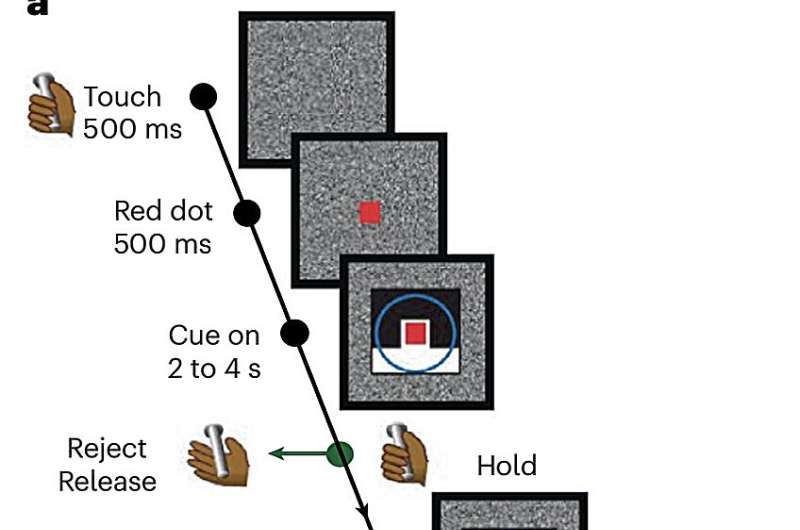October 22, 2023 feature
This article has been reviewed according to Science X's editorial process and policies. Editors have highlighted the following attributes while ensuring the content's credibility:
fact-checked
peer-reviewed publication
trusted source
proofread
Study shows that attractor dynamics in the monkey prefrontal cortex reflect the confidence of decisions

When humans make decisions, such as picking what to eat from a menu, what jumper to buy at a store, what political candidate to vote for, and so on, they might be more or less confident with their choice. If we are less confident and thus experience greater uncertainty in relation to their choice, our choices also tend to be less consistent, meaning that we will be more likely to change our mind before reaching a final decision.
While neuroscientists have been exploring the neural underpinnings decision-making for decades, many questions are still unanswered. For instance, how neural network computations support decision-making under varying levels of certainty remain poorly understood.
Researchers at the National Institute of Mental Health in Bethesda, Maryland recently carried out a study on rhesus monkeys aimed at better understanding the neural network dynamics associated with decision confidence. Their paper, published in Nature Neuroscience, offers evidence that energy landscapes in the prefrontal cortex can predict the consistency of choices made by monkeys, which is in turn a sign of the animals' confidence in their decisions.
"Decisions are made with different degrees of consistency, and this consistency can be linked to the confidence that the best choice has been made," Siyu Wang, Rossella Falcone and their colleagues wrote in their paper. "Theoretical work suggests that attractor dynamics in networks can account for choice consistency, but how this is implemented in the brain remains unclear. We provide evidence that the energy landscape around attractor basins in population neural activity in the prefrontal cortex reflects choice consistency."
In neuroscience, attractor networks are dynamical networks comprised of neurons that converge to sustain specific patterns of activity over time. To investigate the link between these networks' dynamics and confidence in decisions, the researchers carried out a series of experiments on monkeys.
These monkeys were taught to complete a decision-making task. As they completed this task, Wang, Falcone and their colleagues recorded the extracellular activity of neurons in their prefrontal cortex using a bilateral implant containing eight arrays of electrodes.
"We trained two rhesus monkeys to make accept/reject decisions based on pretrained visual cues that signaled reward offers with different magnitudes and delays to reward," Wang, Falcone and their colleagues explained in their paper. "Monkeys made consistent decisions for very good and very bad offers, but decisions were less consistent for intermediate offers. Analysis of neural data showed that the attractor basins around patterns of activity reflecting decisions had steeper landscapes for offers that led to consistent decisions."
Most notably, this team of researchers was able to link the computations performed by neural networks in the prefrontal cortex to the consistency of decisions. Their observations suggest that neural dynamics in the prefrontal cortex predict how quickly monkeys respond on a decision-making task and how consistent their decisions will be, both of which have been linked to higher levels of confidence in a decision.
While the team's findings are preliminary, they highlight the potential of examining several simultaneously recorded neurons to shed more light on specific aspects of decision-making. In the future, their work could pave the way for important new discoveries about how confidence in decisions is reflected by attractor network dynamics and computations performed in the brain.
More information: Siyu Wang et al, Attractor dynamics reflect decision confidence in macaque prefrontal cortex, Nature Neuroscience (2023). DOI: 10.1038/s41593-023-01445-x.
© 2023 Science X Network





















